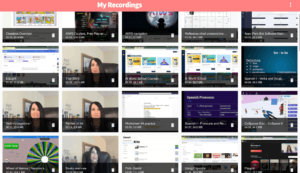10 Tools to Create Online Student Portfolios

Hannah Dickins
The digital revolution encompasses every aspect of our lives – especially learning. One of the most promising learning opportunities brought by this transformation is the possibility of creating online student portfolios. Instructors can use portfolio options, in conjunction with data backpacks, to teach students how to build a narrative of their growth and achievement – a skill they can use in both their personal and professional development. The best portfolios are those which are compiled by students themselves. Fortunately, there are many tools available for crafting engaging digital student portfolios – here are 10 best picks for fostering this creative exercise in the classroom.
1. Kidblog
This is an excellent tool which was actually built by teachers with online student portfolios in mind. Kidblog is a unique proposition in the sense that it aims to empower teachers to fully embrace the advantages of the digital revolution in education by allowing students to become creators, not mere consumers of knowledge. Kidblog offers functionalities which perfectly match the goals of online student portfolios.
Moreover, it grants teachers administrative control over student blogs and accounts to ensure the efficiency and security of the project – the platform doesn’t require any personal data for registration. A word about security – Kidblog is private, but teachers can make posts available to the public or protect them with a password so that parents can have access to their kids’ blogs.
2. Edublogs
At a first glance, Edublogs seems to offer a similar blogging platform to WordPress, but it differs in its core character as a tool meant exclusively for students. What does it mean in practice? Simpler interface and full functionality. Edublogs is a secure platform where blogs can be private or accessible to teachers, classmates and parents.
3. Three Ring
This mobile app that boasts a desktop version offers some valuable functionalities. Three Ring is a tool where students can create and upload content from their own devices and then categorize it with tags. Portfolios are fully searchable and items can be easily shared with other users. Teachers can create special class accounts and add students from each class, monitoring how these accounts are being used. Each student receives a username and password, and can access their portfolio from any device equipped with iOS or Android, as well as desktop and laptop computers. Teachers can send links to student accounts to parents so they can have a look at their child’s progress.
4. VoiceThread
This free app for iOS is another interesting tool for creating digital portfolios. Teachers and students can work together and add work samples which are then organized to form separate streams and narratives. The app supports different types of content, ranging from audio and video to images and other kinds of files or documents.
5. Weebly
Weebly is a platform which helps students to create websites with the use of specific visual templates. As you can imagine, this tool can easily serve as a digital portfolio creator, helping students to navigate through its simple interface and easily update their portfolios. Students can add content with a simple drag-and-drop – this means that the tool will work for younger students. Weebly offers a look into portfolios made by other students as well, helping to inspire students and their peers in creating captivating online spaces.
6. WordPress
Easily the largest blogging platform on the web, WordPress is a popular choice for all kinds of ventures. Getting familiar early on with its many functionalities is a great advantage and will bring benefits to students in their careers. For the purpose of a portfolio, WordPress is a great choice – it features an understandable dashboard where students can upload files of different formats and create their online space. Choosing from a number of free themes, they can create a website that perfectly captures their personality.
Using forms like posts and pages, students can document their work throughout the year. They’ll be able to revisit their creation later in life too. While for some students WordPress may generate a slight learning curve at the beginning, having a blog set up and managing it is really simple. Teachers interested in introducing WordPress to their classroom should remember to choose WordPress.com – WordPress.org is a bit more advanced and requires payment for each domain name.
7. Google Sites
If you’re already using Google Apps for Education at your institution, choosing Google Sites as your go-to tool for creating engaging student portfolios will be only natural. Google Sites offers an interface enabling students to create comprehensive and varied collections of multimedia materials to craft a narrative of their work throughout the school year. The tool provides site templates, so students won’t need to work on the site structure at all. All they need to do is integrate their site with other Google apps to create their online portfolios. Since it’s a Google product, you can expect Google Sites to seamlessly integrate with other tools like YouTube, Blogger or Slides. Naturally, it will be part of a student’s Google Apps account, so teachers will have full administrative control over how sites are being used and their accessibility to the public.
8. Evernote
With Evernote, students can write down notes, take photos, upload their own content, record audio and tag all items with specific keywords. They can then organize the content into notebooks and groups, sharing it all to their social networks. Evernote is a great choice for classrooms working with BYOD. The tool constantly synchronizes across different devices, be it desktop computers, laptops, tablets or smartphones. This essentially means that students can continue adding new content to their portfolios and arraigning it into a meaningful whole at all times and in any place. Moreover, Evernote includes a range of its own apps – for instance Skitch, a tool for giving annotations which works great with other Evernote content. Needless to say, teachers won’t be able to constantly monitor student-generated content on Evernote – but at least they can be sure that the public won’t be able to access it either.
9. Easy Portfolios
This is an iOS app, which costs less than $2 and can bring many benefits to the classroom. Students can use its simple interface to create and manage classes and portfolios, recording audio and capturing pictures directly to their collections. Files stored on Dropbox can be transported here without any fuss.
10. Wikispaces for Education
This Wiki-powered website is free to use and will be just perfect for classrooms where access to apps is a challenge. All teachers need for this one are computers. Wikispaces can work like a blogging platform for students. Teachers need to create a community for the class and then provide students with their own space to publish their work.
Each student receives their own username and password, but they won’t need to add their email for registration. These communities can be set up as private, so there’s no privacy concern here.
Digital portfolios empower students and help them see the path of their learning experience. This is how they can grow to appreciate and manage their achievements. Moreover, by introducing digital portfolios to a classroom, teachers can foster digital skills to make out of their students true digital citizens.
For more on portfolios, check out:
Hannah Dickins is a Community Manager at Directorstats.co.uk. Follow Hannah on Twitter, @DickinsHannah.
Stay in-the-know with all things EdTech and innovations in learning by signing up to receive the weekly Smart Update.







Gideon Williams
Great post, many thanks.
Don't forget Mahara. Open source, links to many VLEs like Moodle and Canvas. Enables students to create multimedia pages using different layouts. Students can upload files and create links. They can also share the pages anonymously with other users and get feedback.
Felix
Another great online portfolio builder is Format.com. It is easy-to-use, easy-to-maintain and geared towards creative professionals (photographers, illustrators, designers, artists etc...). Their features are focused and deep and they’ve gone to great lengths to provide users what they really want most: powerful control over how their work is displayed. Time and again they’ve provided multiple options for their customers where competitors take the easy way out, showing a dedication and craft that is sorely lacking among Format’s competition.
Sam Jackson
Great post and timely since students (and adults) need portfolios today.
Check out trovvit,com.
I had used Evernote and dropbox for my kids but trovvit is amazing. It is private, kids-safe and can be used to store all sorts of learning accomplishments, documents, movies, photos and more in my or my kids "trove". These can be shared in a private feed with others or curated and added to their portfolio (which can be private or public). Very cool.
Matt
I really like portfoliolounge.com
David
IM Creator now offers a free license to students, allowing them to build their own websites and portfolios without intrusive ads or unattractive domains.
Students can apply at https://www.imcreator.com/students and get their free license in just a couple days :)
ayushi
Great article. Keep doing a great job.
MOUTHEDBlog
nice article
Jagconsulting
It's very nice thought to post an article on this topic. This blog will be helpful to all students for making online student portfolios. I really appreciate your ideas. Keep posting!